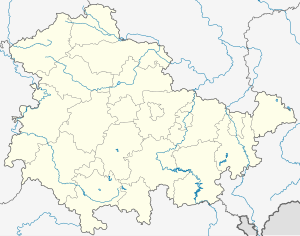Werra Bridge in Creuzburg
Coordinates: 51 ° 2 ′ 58 ″ N , 10 ° 15 ′ 7 ″ E
| Werra Bridge in Creuzburg | ||
|---|---|---|
| Werra Bridge with Liborius Chapel | ||
| use | footbridge | |
| Crossing of | Werra | |
| place | Creuzburg | |
| construction | Stone arch bridge | |
| overall length | 86 m | |
| width | 5.50 m | |
| Headroom | 3.5 m | |
| start of building | 1223 | |
| completion | 1224 | |
| location | ||
|
|
||
The Werra bridge in Creuzburg was built in 1223 and is the oldest preserved natural stone bridge in the eastern federal states. The stone arch bridge spans the Werra in the Thuringian town of Creuzburg with a length of 86 meters .
history

In place of a wooden bridge, Landgrave Ludwig IV had the stone bridge built in 1223. The structure was secured by a defensive tower on the eastern bridgehead. The bridge is said to have been connected to the "Eisenacher Tor" of the Creuzburg city wall, 200 m away.
A little later a wooden chapel, dedicated to the patron saint Liborius , was built on the eastern bank downstream , which was replaced in 1499 by a Liborius chapel built in the late Gothic style .
In 1717 the bridge tower was demolished, from 1747 to 1752 extensive repair and renovation work was carried out to repair flood damage under the direction of Gottfried Heinrich Krohne . At the beginning of the 20th century, the building was part of Reichsstrasse 7 . On April 1, 1945, two arches of the bridge were blown up by the Wehrmacht , the reconstruction lasted until 1952.
Due to the risk of collapse due to inadequate maintenance and increasing traffic loads , a new Werra bridge made of prestressed concrete was built in 1986 about 100 meters upstream , over which today's federal road 7 runs.
The natural stone bridge was repaired from 1992 to 1993 for around two million DM and is a listed building.
construction

The 86 m long bridge consists of natural stone masonry and has seven semicircular arches . In the eastern part it rests on a rock bar in the river. Yellow sandstone and limestone from local quarries were used as building materials . The six stone pillars are reinforced upstream with wedge-shaped icebreakers ; downstream the pillars are rounded off in a semicircle. The three central pillars have semicircular escape pulpits upstream and downstream. Only four pillars are permanently in the water.
The clear widths of the openings are from west to east: 4.72 m, 6.31 m, 6.20 m, 8.40 m, 9.37 m, 9.27 m and 9.15 m with pillar widths of 4, 50 m, 3 × 5.00 m, 6.00 m and 3.55 m. The width of the carriageway between the sandstone parapets varies between 5.27 m and 5.62 m. A 31 m (in the west) and 14 m (in the east) long brick ramp adjoin the bridge abutments.
The complex repair was necessary because large parts of the downstream end walls and the western vaulted arches no longer had sufficient stability. The masonry and vault damage could be repaired by installing stabilizing concrete shells over the vaults. The masonry was repaired largely true to the original.
See also
literature
- Ulrich Grabalowski: Werra Bridge, Creuzburg. In: Stone bridges in Germany. Verlag Bau + Technik, Düsseldorf 1999, ISBN 3-7640-0389-8 , pp. 363-367.
Web links

